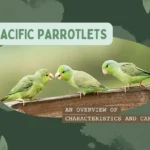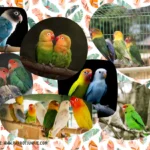
Lovebirds – An Overview of Characteristics and Care
Lovebirds are a captivating group of small parrots renowned for their vibrant colors, sociable behavior, and strong pair bonds, earning them their romantic moniker. Native to the African continent and the Indian Ocean islands, these birds belong to the taxonomic genus Agapornis and include nine distinct species, each with their unique characteristics and habitats. The nine species are:
- Agapornis roseicollis – Rosy-faced lovebirds or peach-faced lovebirds
- Agapornis personatus – Masked lovebirds or yellow-collared lovebirds
- Agapornis fischeri – Fischer’s lovebirds
- Agapornis lilianae – Lilian’s lovebirds
- Agapornis nigrigenis – Black-cheeked lovebirds
- Agapornis canus – Madagascar lovebirds or grey-headed lovebirds
- Agapornis taranta – Abyssinian lovebirds or black-winged lovebirds
- Agapornis pullarius – Red-headed lovebirds or red-faced lovebirds
- Agapornis swindernianus – Swindern’s lovebirds or black-collared lovebirds
Jump To Section
Classification and Distribution
The genus Agapornis is part of the Old World parrot family Psittaculidae. The nine species include the peach-faced, Fischer’s, and masked lovebirds, which are the most commonly kept as pets. All of the species are predominantly green, but they also exhibit vibrant colors such as orange, yellow, gray, black, or red on their bodies, contributing to their captivating appearance.
Lovebirds primarily inhabit central and southern Africa, and Indian Ocean islands, with species such as the grey-headed lovebird native to Madagascar. Despite being native to Africa, a feral population of lovebirds has also been spotted in areas in the United States such as Arizona and Texas.
Physical Characteristics
Lovebirds are small parrots, with their sizes ranging from just over 5 inches (~13 cm) to just over 6½ inches (~16.5 cm). They are stockier compared to some other small parrots like budgies, and they have short, blunt tail feathers. Their heads are rounded, and they possess relatively large beaks for their size.
Behavior and Pairing
The social behavior of lovebirds is one of their most defining traits. They form strong pair bonds, which has led to their common name, “lovebirds”. Despite this moniker, it is a myth that they must always be kept in pairs; in fact, many breeders argue for keeping lovebirds as single pets, with the owner or the owner’s family acting as the lovebird’s flock.
This approach enables a strong bond to develop between the bird and its human caretaker, which can be very rewarding for both parties. It should be kept in mind that pairing up lovebirds does not guarantee pair bonding, and many disappointed owners have found that they end up needing to set up a separate cage for the second lovebird instead.
Lovebirds are renowned for their playful and engaging personalities. Their lively, cheerful demeanor can bring much joy to their owners, making them a popular choice as pets. They are also known for their bright and diverse chirps, and wonderfully bubbly personality.
Intelligence and Communication
Despite being a type of parrot, lovebirds typically do not mimic human speech. However, they are quite intelligent and can communicate their needs and moods through a variety of sounds and body language. Individual birds that are motivated by treats and interaction can be easily trained to do tricks and respond to commands.
Diet
Lovebirds mainly feed on seeds in the wild, but a balanced diet for a pet lovebird should also include fresh vegetables and fruits. A well-rounded diet ensures that the bird receives all the necessary nutrients for optimal health and well-being. A good base diet for lovebirds includes a mix of seeds, grains, and pellets specially formulated for their nutritional needs.
Supplementing their diet with fresh produce such as leafy greens, carrots, and apples provides essential vitamins and minerals. It’s important to avoid feeding lovebirds foods that are toxic to them, including avocado, chocolate, caffeine, and alcohol. Clean, fresh water should always be available. Regularly monitoring their weight and consulting a veterinarian can help maintain and diet for them.
Cage Size and Environment
The minimum cage size for a lovebird should be at least 18 inches (~45 cm) each in length, width, and height. This size provides enough space for the lovebird to stretch its wings, hop around, and engage in natural behaviors. However, it’s important to note that the more space you can provide, the better it is for the bird’s physical and mental well-being.
Lovebirds are active and curious creatures, so a larger cage or aviary is always recommended if possible. Additionally, the cage should have horizontal bars for the lovebird to climb on and should be equipped with a variety of perches with different textures, shreddable toys, and food and water dishes that are kept clean and hygienic.
As mentioned earlier, it is not always necessary to get lovebirds in a pair, however, these birds can also thrive well in small flocks. For every additional bird you add to the flock, it is advisable to increase the size of the cage to ensure that all birds have sufficient space to move around and avoid overcrowding. While lovebirds of different species can coexist in the same cage or aviary, it is not advisable to allow interspecies breeding as this can lead to hybrid lovebirds.
Final Notes
In conclusion, lovebirds are captivating avian companions that bring joy and beauty to our lives. Their vibrant colors, affectionate nature, and melodious songs make them a popular choice for bird enthusiasts. Whether you’re considering getting a lovebird as a pet, learning about their care and behavior, or exploring the possibility of breeding these charming birds, it’s important to prioritize their well-being.
Providing a spacious and enriching environment, a balanced diet, and plenty of love and attention are essential for their happiness. By understanding and meeting their unique needs, lovebirds can flourish as cherished companions, bringing a delightful touch of nature’s splendor into our homes.
Parrot Junkie www.parrotjunkie.com
Copyright © 2021-2024. All rights reserved.



Be the first to leave a comment